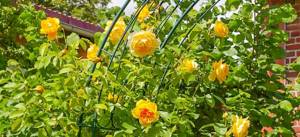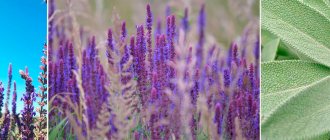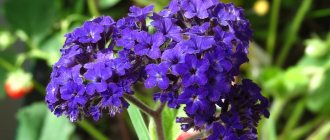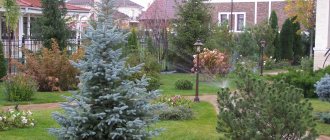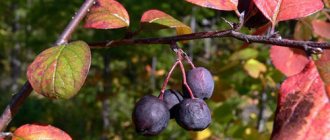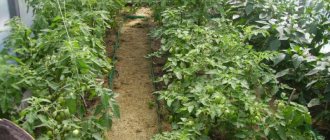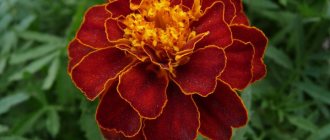Description of climbing roses
Among the distinctive features of this culture are:
- impressive length of shoots. Thanks to this, the support located nearby is quickly entwined with flexible branches. If everything is done correctly, the summer resident will receive a harmonious garden design;
- a variety of colors. The plants resemble groundcover and park varieties. Roses begin to bloom in June;
- subtle aroma. Its intensity is largely determined by growing conditions and varietal characteristics.
Groups and varieties of climbing roses
Climbing roses are divided into several groups. The determining factor is the height of the plant. Semi-climbing varieties reach no more than 5 m, climbing ones - up to 15 cm.
Roses can bloom one or several times. It depends on the varietal characteristics.
Rambler
Ramblers are climbing roses that are planted as decoration for gazebos, facades and other garden buildings. The length of flexible shoots often reaches 6 m. These varieties require support.
The foliage is in most cases dark green. Double inflorescences are formed from neat rosettes. They appear only on last year's shoots. Experienced gardeners consider the only drawback to be that the flowering period is too short. Usually it lasts no longer than 7-10 days.
| Variety | Description |
| Crimson | Up to 4 m. Blooming flowers are less than 5 cm in diameter. Carmine-red roses are collected in impressive inflorescences. There is no smell. |
| Albrighton | Cream and soft pink cup-shaped buds. The petals are arranged in waves. The closer to the center, the smaller their size. The diameter of the flower is 5 cm. This variety is not afraid of rain. |
| Manninkton Mov | Dark lilac roses that become noticeably lighter over time. They are small in size (no more than 3 cm). During the flowering period, the dense green foliage is covered with bright inflorescences. There are practically no thorns on the shoots. |
| Goldfinch | Small leaf blades are colored emerald. On strong flexible lashes, thorns are most often absent. |
Climbers
This category includes repeat-blooming roses, characterized by high winter hardiness. Many of these varieties can be grown in the middle zone. Climbers were obtained as a result of selection of climbing varieties with floribunda, tea, hybrid and remontant roses.
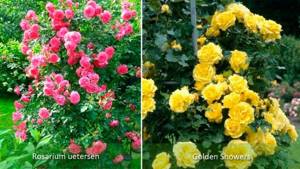
Features of the varieties included in this group include elongated branches and intensive growth. Beautiful openwork inflorescences form from blossoming roses.
| Variety | Description |
| New Dawn | The height of the bush reaches 2 m. Thin shoots branch in different directions. Due to the abundance of blooming roses, the branches bend down during the flowering period. The leaves are greenish-gray, the intensity of the color depends on the lighting. |
| Breath of Life | The bush is formed by powerful shoots. The diameter of large soft apricot flowers varies from 10 to 11 cm. Each inflorescence is formed from three buds. Rainy weather causes the tender buds to turn brown. |
| Golden Showers | Height varies from 2 to 3 m. On vigorous shoots, leaf blades are painted in a rich green tint. Semi-double buds are collected from wavy petals. At the beginning of the flowering period they are bright yellow. Later the roses become creamy. |
| Сompassion | The bushes are no higher than 3.5 m. They are formed by erect stems, on the surface of which there are many thorns. A strong sweetish aroma emanates from the terry soft apricot buds. |
| Rosarium uetersen | Green leaves become the background for large flowers formed from double petals. Flowers are characterized by good winter hardiness. |
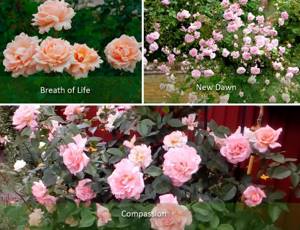
Claimings
The whip-like branches of these roses are stiffer than those of other varieties. The length of the shoots is usually 2-3 meters. Gardeners often arrange their climbers in the shape of a fan.

Obvious advantages include disease resistance and frost resistance. Through this garden plant, pergolas, arches and other vertical surfaces are decorated.
| Variety | Description |
| City of York | Height - up to 7 m. Flexible shoots are covered with thorns, white-cream flowers are decorated with golden specks. The foliage is bright green. Roses give off a pleasant aroma. |
| Gloria Day | Not higher than 3 m. Rich green leaves, yellow-cream double flowers. Their diameter varies from 11 to 15 cm. The branches have thorns. |
| Coral Dawn | Terry spherical inflorescences of a pink-coral hue. Long and abundant flowering, high winter hardiness. |
| Cecilia Brunner | Height - more than 4 m. The branches are covered with green foliage. Roses are collected from double petals. |

Variety Gloria Day
Cordesa
Roses from this category are characterized by the following features:
- powerful bushes;
- re-blooming; shoots whose length ranges from 1.5 to 3 m.
These flowers are often classified as semi-climbing.
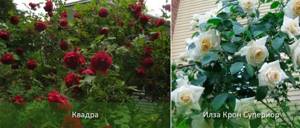
| Variety | Description |
| Quadra | The height of the bush reaches 1.8 m, the width is 1 m. Bright red flowers can be arranged either separately from each other or together. |
| Ilsa Kron Superior | The flowers are goblet-shaped. The height is 2-3 m. The brushes are collected from beautiful white roses. |
Winter-hardy varieties of climbing roses
Frost-resistant varieties are especially popular.
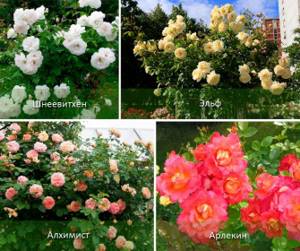
Their list is quite extensive.
| Variety | Peculiarities | Flowers | Application |
| Harlequin | Short flowering period. | White core and petals decorated with pink outline. | Landscape design. |
| Alchemist | Difficult to grow, short flowering. Strong aroma and many thorns. | Golden yellow. | Design of garden buildings. |
| Schneewithchen | Creeping shoots are light green, shiny foliage, sweet aroma. | Snow-white, semi-double. Diameter – from 5 to 9 cm. | Decoration of tall buildings. |
| Elf | Persistent fruity scent. | White, with a greenish tint. Wave-shaped flowering. | The buds are of medium size. Decoration of a personal plot. |
Varieties of climbing roses of continuous flowering
These varieties require more careful care.
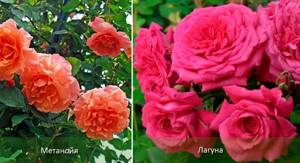
The popularity of varieties characterized by continuous flowering is often explained by their high decorative value.
| Variety | Description | Flowers |
| Lagoon | Distinctive features include a strong floral aroma. The bush reaches a height of 2-2.5 m. The plant needs dense shelter. | The brushes are formed from large velvet roses. They can be light pink and red. |
| Rumba | The length of the shoots varies from 1 to 3 m. They are resistant to sudden changes in temperature. | Painted in golden and pink shades. |
| Golden Perfume | Alluring smell, lack of winter hardiness. | The diameter of the yellow rose does not exceed 12 cm. |
| Metanoia | Light unobtrusive aroma, the bush is lush. | Large orange and salmon buds. |
| Giardina | No thorns, fruity aroma. | Pink peony-shaped buds collected from densely double petals. |

Predecessors of climbing roses
The origin of climbing varieties is associated with two wild species - Multiflora and Rosehip Vikhura.
Multiflora
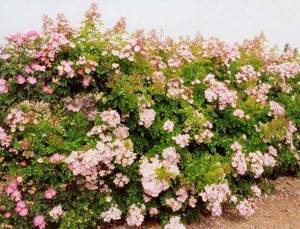
Rosehip multiflora or multiflora is native to Japan, Korea, and the island of Taiwan. It has long flexible shoots up to 3 meters long and numerous white or pink flowers about 2 cm in diameter with a faint cinnamon scent. Once in Europe, this rose hip was enthusiastically received, and is still found in parks and large areas. It is often used to create hedges. It is distinguished by lush, abundant flowering throughout the month.
Rosehip Vikhura
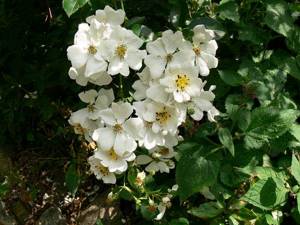
This rose hip came to Europe from China, Korea, Japan, and the Philippines. In its homeland it forms picturesque bush thickets. The outstretched bushes can reach almost two meters in height, but almost 6 meters in width. They are distinguished by white or pink fragrant flowers that are quite large for a rosehip - 1.5-3.0 cm in diameter.
Special varieties of climbing roses
Among gardeners, varieties are quite popular, characterized by winter hardiness and constant flowering.

| Variety | Flowers | Peculiarities |
| Parade | Roses characterized by a variety of colors and oval shape. The diameter does not exceed 10 cm. The buds can be located both together and separately. | Lush bush, thin leaf blades of an emerald hue. Plant height - no more than 3.5 m. |
| Amadeus | Red, impressive size. | Intensely fruity scent. The height of the bush reaches 6 m. |
Varieties of climbing roses by color scheme
The shade is taken into account when choosing suitable varieties.

Roses are planted to decorate decorative buildings.
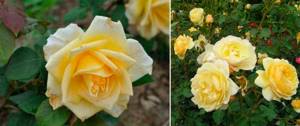
Variety Elegance
Thanks to the rich color of the leaves and the brightness of the buds, any garden composition will become unique.

| Color | Variety | Description | Peculiarities |
| Reds | Orfeo | Scarlet roses, the diameter of which does not exceed 10 cm. | Pronounced spicy aroma. Needs additional protection. |
| Orange Meilandina | Small red buds, a bush whose height is 2 m. | Frost-resistant, weak floral scent. | |
| Salita | The petals are colored salmon-orange and red. The buds in appearance resemble hybrids of tea varieties. | Rich fruity smell, continuous flowering. | |
| Yellow | Elegance | Terry roses are large in size. Each bud has from 40 to 60 petals. The shoots are covered with thorns. | High winter hardiness, fragrant aroma. The plant needs shelter. |
| White | Schneewaltzer | Pearl petals are velvety. You can see yellow highlights at the core. The diameter of roses reaches 18 cm. | They last a long time when cut. |
| Schwanensee | The diameter of the rose is from 6 to 8 cm. The length of the shoots is no more than 6 m. | Continuous flowering, need for timely pruning. | |
| Pink | Lavinia | Bright pink small buds. | Average frost resistance, long budding. |
| Jasmine | Roses are characterized by a lilac-pink color. | Fragrant sweet smell, a large number of flowers. | |
| Blue | Indigoletta | Lilac velvety buds of large size. | Does not take root well in the middle zone. |
| Blue Moon | The diameter of the flowers is no more than 12 cm. | Color depends on lighting. |
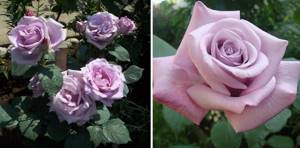
Variety Blue Moon
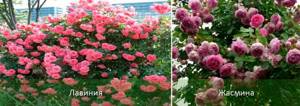
Care and cultivation of climbing roses

Rose care
There is a decorative type of perennial shrub called climbing rose. Despite the fact that roses are similar to each other, they still have some differences:
- climbing rose reaches 15 m in length;
- the stems are able to cling to the support themselves due to the tendrils;
- the bush is easy to shape.
Ground cover roses: care and cultivation
To grow a beautiful and healthy bush, you need to know about important points:
- The rose should be planted in a sunny, ventilated place. Optimal south and south-west exposure. Under the most comfortable conditions, the rose will begin to bloom in the second year.
- Open ground should be fertile with drainage.
- Bushes should be planted at a distance of at least 50 cm from each other. Over the years, the roots will have little room and will deplete the soil around the bushes.
- For a healthy and properly formed bush, timely pruning is necessary. It is recommended to prune in late August - early September.
- Rose staking occurs at an early stage to control the direction of shoot growth.
- The climbing rose is frost-resistant, but it still needs to be wrapped in winter. Preparations for wintering begin in the fall. To begin with, loosening the soil and fertilizing it stops. The number of waterings is also reduced. Bushes take shelter during the onset of the first frosts. In order for the rose to withstand the cold well, when wrapping it is worth leaving an air gap between the film and the crown.
- If it is possible to remove the rose from the support, you can rewind it with twine and lay it on a layer of leaves. The top is also covered with leaves, burlap or oilcloth.
- Most often, climbing roses are planted in groups. Other types of flowers should not be located nearby. The exception is trees - apple, pear or rowan.
Note! If the climbing rose is securely attached to the support, you should not try to remove it. Such actions can damage the shoots. The rose is covered with spruce wood and wrapped in burlap.
Planting climbing roses in open ground
To achieve abundant flowering, the gardener needs to regularly carry out all agrotechnical activities. Climbing roses are considered plants that do not like excessive moisture and drafts. The bed should have a slope. This is necessary to eliminate excess water. The length of the roots is 2 m.
Climbing roses are often planted along walls and fences. Plants will feel comfortable if there is at least 60 cm between the building and the root system. Cones, fences, pillars, nets, arches and pergolas are also used as support.
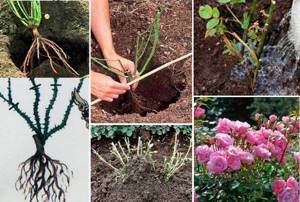
The landing algorithm is quite simple:
- In the selected area, dig the required number of holes.
- A nutrient mixture is placed in each of them, which can become peat compost.
- Plants are carefully planted in prepared holes and watered with warm water.
- At the last stage, the soil must be compacted.
What you should know about climbing roses: recommendations from a professional
Pruning and care
There are specifics to pruning Rambler class roses:
- it should be carried out immediately after the completion of the flowering phase;
- shoots older than two years of age are cut out completely, at soil level;
- in the spring, after sanitary pruning, the side shoots are cut to a length of no more than 15 cm;
- young shoots ripen better along their entire length and winter well if their tops are pinched into 3–4 leaves in early September.
These roses create two problems: excessive growth and a persistent tendency to powdery mildew .
Attempts to contain the growth fail, and experienced gardeners advise allowing these roses to grow freely. Some varieties grow so vigorously that they are not suitable for a small garden. In addition, modern rose lovers are no longer satisfied with a one-time - even abundant and long - flowering. However, the main problem with these roses is powdery mildew. The once-blooming rose 'Excelsa' did not survive in this planting and had to be replaced due to severe powdery mildew damage
Powdery mildew is an eternal companion of once-blooming ramblers. The causative agent of this disease is the fungus Podosphaera pannosa (Wallr), de Bary. The viability of the infectious structures of the fungus lasts only a few hours, but the potential for infection development is enormous.
Any varieties of roses that are prone to powdery mildew, especially ramblers, should not be planted near walls or in places protected from the wind. It is better to choose places with good air circulation for such plants. Regular watering and loosening of the soil to prevent moisture loss during hot and dry summers can somewhat reduce the severity of symptoms in susceptible varieties.
Approved preparations for the control of powdery mildew on roses : Alirin-B, TAB (titer not less than 109 CFU/g); Topaz, EC (100g/l); Skor, EC (250g/l); phytosporin-M, P (titer of at least 2 billion living cells and spores).
You can find fungicides for effective control of fungal diseases of roses and their prevention in our catalog, which combines offers from large garden online stores. Choose drugs to protect roses from diseases .
Fitoverm (against ticks, aphids, caterpillars), 2 ml x 2 41 rub.
seedspost.ru
Probiotic tar soap Kysh-Vestitel, 0.5 l 316 rub.
seedspost.ru
Profit Gold (against late blight), 3 g 63 rub.
seedspost.ru
SKOR, 2x2 ml 124 rub.
seedspost.ru
Sometimes, at the wrong planting site, even with the most careful care, the symptoms of the disease in some varieties of this group are so pronounced, and the therapeutic effect of the use of even modern drugs is so insignificant that this can prompt a radical solution.
'Excelsa' on a retaining wall proved to be a poor solution due to its high susceptibility to powdery mildew. She had to be replaced
Sick plants are not only a loss of decorative value, but also a constant source of infection. Although, if you don’t get carried away with quantity and provide good ventilation conditions, then the problem of powdery mildew can be kept under control.
Ads by
Optimal time and place for landing
The site is chosen based on the needs of the plant. It should be well lit and ventilated. Sandstones and heavy clay soils are not suitable. The same can be said about wetlands.
In the middle zone, planting is carried out at the end of the first autumn month. In the northern regions, the crop is placed in the spring. The land should be ready two months before planting.
Autumn planting
This method has its advantages and disadvantages. The first include:
- Temperature stability.
- Favorable conditions for faster rooting of climbing roses and growth of green mass.
- Variety of planting material and low cost.
Rose varieties that bloom in spring are recommended to be planted in autumn.
Spring planting
In this case, the climbing rose is placed in open ground in early spring. This is due to the following reasons:
- The kidneys are in a dormant state.
- The soil is sufficiently moist.
- The temperature rises gradually.
The disadvantages include weakness and insufficient adaptation of the plant. Climbing rose bushes planted in the first months of spring are 2 weeks behind in growth.
Care and fertilization
It is not for nothing that climbing roses are considered one of the most capricious plants - growing and caring for them really require a lot of attention. Therefore, from the moment of planting, you need to carefully monitor and care for the plant to ensure the normal development of the bush.
Immediately after planting, if the plant was planted in the spring, it should be covered with a transparent film, but ventilated every day, leaving it open for at least an hour. The film is only needed while frost is possible. The ground around the bush must be constantly loosened and hilled to retain moisture, and also weeded so that the weed does not interfere with growth.
Anyone who decides to decorate their garden will have to learn how to properly fertilize and prune roses. Every year after the winter insulation is removed from the bush, it is necessary to prune old, dried shoots. For beauty, you can trim the bush as you like, the main thing is not to touch the main vines. A few useful rules to help you prune a bush correctly:
- Be sure to cut with pruners or a sharp knife. You can pre-disinfect the blades with manganese.
- The cut should be 1 cm above the top bud (unless the goal is to cut off an unnecessary shoot).
- Bushes should be trimmed in sunny weather, they should be dry.
- The cut must be made at an acute angle. This is necessary so that the water can roll off without lingering on the cut.
- Be sure to treat the cuts with garden varnish or Novikov liquid.
Such plants do not require frequent watering, so it is enough to water them with 15 liters of water once a week. It is possible more often, but then it is necessary to use smaller volumes of water for each watering, for example, when watering twice a week - no more than 7.5 liters at a time. Of course, watering must be done adjusted to the weather: in dry summers you can use 20 liters of water.
Fertilizing climbing roses also requires attention. At different periods of a plant's life, it should be fertilized differently, but the first three years are especially important for normal growth.
In the first year, the plants should not be fertilized throughout the summer, since at the time of planting the soil was already fertilized with manure. Before preparing for winter, perhaps in mid-autumn, it is enough to treat the soil with potassium fertilizers so that the plant can more easily withstand frosts.
In the second year, it is possible (and even necessary) to use both mineral and organic fertilizers, and it is necessary to alternate them, enriching the soil alternately with different substances.
Starting from the third year, you need to use only organic fertilizers. But we must not forget that roses should never be fertilized during the flowering period.
Preparing for winter
Roses need to be covered when the air temperature begins to drop to -5°C, but not earlier. The fact is that if you cover a bush at positive temperatures, a debate may begin, or the bush will continue to grow. Before covering it with insulation, you need to cut off all the dried shoots, then remove the vines from the support and place them on the mat. Vines cannot be placed on bare ground.
When the excess shoots are cut off and the vines are laid on the bedding, they must be tied and covered with any waterproof insulation, be it roofing felt, polyethylene or any other material that does not allow moisture to pass through. The base of the bush must be covered with earth to protect it from frost. All this must be done in dry weather. The bush, vines and shoots must be dry.
Supports and devices
There are many ways to shape a bush. Various arches, nets, pillars and cones for almost every taste. There are no rules or restrictions here, so the gardener has complete freedom of action in this matter, however, when choosing a support, it is important to pay attention to the following qualities:
- Compactness. The task of any support or suspension is not only to give the bush the correct shape, but also to place the plant compactly on the site. If the support does not fulfill this purpose, you can consider other options.
- Size. Each variety has a different length of the vine, this must be taken into account when purchasing or making a support, otherwise it may turn out that most of the arch or pillar of the support is bare, and the shoots barely reach its middle.
- Reliability. Climbing roses at the peak of flowering can weigh very, very decently, so the support should easily hold the plants and have a margin of safety in case of abundant growth.
Any support or structure must fit harmoniously into the overall appearance of the garden without compromising the integrity of the design.
If you follow all the above rules, climbing roses will always bring pleasure to the owner and amaze guests with their beauty. Dense shoots can decorate any garden or yard, bringing a riot of colors characteristic of the queen of flowers.
Caring for a climbing rose in the open ground
Garden crops need loosening and watering. Roses should be planted near a support. In the absence of suitable buildings, metal arches can be used. During autumn replanting, the upper part of the bush must be tied with twine.
Watering
During drought, the area where the roses are planted should be moistened no more than once every 5 days. 3 weeks after planting, you need to rake away excess soil from the bush. Watering is increased more frequently during the growing season. The norm for one adult plant is from 10 to 12 liters. The next day after moistening, the soil needs to be loosened and mulched.
Top dressing
This stage is especially important for climbing roses. Additives containing nitrogen must be alternated with combined mixtures. Plants are fed no more than twice a month. Instructions for use are included with each drug. Roses need not only minerals, but also organic matter.
In this case, fertilizers called “Flower” and “Ideal” will be required. They can be purchased at a specialty store. You can make the mixture yourself. To do this, you will need ingredients such as wood ash and mullein. In July, the soil is fertilized with potassium and phosphorus additives.
Support
Arches are especially popular. To achieve the desired decorative effect, at least 2 bushes are planted at their base. In the second year, the building will be completely braided.
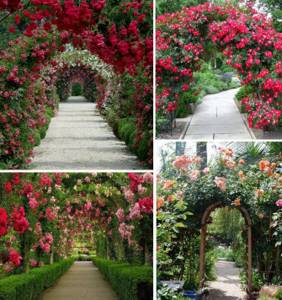
Flowering bushes can be tied up in several ways:
- fan - side shoots are not tied up;
- horizontally - the branches are carefully attached to the support so that new shoots rise upward;
- in a spiral - the stems are twisted around a decorative device.
Transfer
It is best to do it in September. If the agrotechnical measure is scheduled for a later date, the plant will not adapt to the cold. To remove the root system from the ground, the plant is dug up. After removing excess soil from the roots, the rose needs to be moved to a new hole.
Trimming
The time for the procedure depends on when flowering begins. As a result of pruning, the shoots become 30 cm shorter. The stems are removed during the formation of the crown of the bush. The same is done with branches that thicken the crown, and buds that have already faded. By pruning, the gardener provides thermal insulation for the plant before wintering. At this stage, foliage and old shoots must be removed.
The right garter is the key to a beautiful bush
After pruning, the bush begins to grow new shoots. In order to give a climbing rose the correct shape, the shoots must be tied up correctly.
If, when tying, you direct the branches only upward, then the shoots will bloom only at the top. Try to tie the branches at an angle. There are several ways to tie
- A fan-shaped garter requires only the center branches to be placed. The side shoots remain free to grow to the sides.
- When the main trunks are tied horizontally, the growth of new shoots forms a fluffy, flowering cloud around the bush.
- To create a flowering column or arch, direct the main shoots in a spiral.
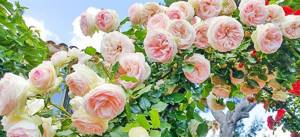
Reproduction
Climbing roses are propagated by grafting, seeds, layering, and cuttings. The latter are used more often than others. Seed material should be purchased at the store. Seeds obtained on a personal plot will not give the desired harvest.
Seeds
First, the seed is placed in hydrogen peroxide. This is how mold is prevented. Half an hour after the start of the procedure, the seeds are removed and laid out on a cotton napkin. They are covered on top with a layer of cotton soaked in the same solution. After the seeds germinate, they are transferred to glasses filled with soil mixture.
Cuttings
They are cut in mid-summer. Suitable branches are pre-selected. The next step is to determine the points where the cut will be located. The top one is made flat, the bottom one at an angle of 45 degrees.
The treated cuttings are placed in containers filled with a mixture of soil and sand. The upper part is covered with a glass jar. To speed up rooting, water the cuttings regularly.
By layering
Cuts on the shoot are made under the buds. Humus is placed at the bottom. Fertile soil is poured on top of it. The next step is bending down the selected shoot. Metal staples are used to secure it. Afterwards the plant is buried. The top should remain outside.
Graft
Climbing roses are most often grafted onto rose hips. The procedure is carried out in late July - early August. The algorithm is quite simple:
- Rose hips are watered abundantly.
- The neck is cut.
- A peephole taken from the plant is placed in the resulting pocket.
- The treated area is wrapped with a special film.
- The bush is being spudded.
Mr. Summer Resident warns: reasons for the lack of flowering in climbing roses
If a climbing rose does not bloom on time, the gardener should analyze his actions. It is quite possible that the malaise was caused by his mistakes.
| Cause | Prevention and treatment measures |
| Diseases | Timely spraying with Bordeaux mixture. Adding complexes containing potassium and superphosphates. Affected branches are removed. |
| Extra branches | Regular removal of wild shoots. |
| Insufficient thermal insulation | If everything is done correctly, the rose will not suffer from temperature changes and dampness. Mandatory measures include moderate watering and potassium fertilizing. Loosening the soil will have to be abandoned. |
| Excessive nitrogen concentration | This element provokes an accelerated growth of green mass. To get rid of negative consequences, you should forget about nitrogen-containing fertilizers. |
Thanks to the variety of assortment, every summer resident will be able to find suitable varieties for himself. When choosing, you need to focus on the color, size, shape, height and configuration of the plant. Particular attention should be paid to such qualities as resistance to adverse weather conditions and duration of flowering. Climbing roses are often used for horizontal and vertical gardening.
Fertilizer application scheme for climbing roses
Without timely feeding, a rose will not be able to show its decorative charm.
- The first feeding is carried out after spring sanitary pruning. Add 1⁄4 buckets of rotted manure and 20 grams. ammonium nitrate, under the bush. Loosen and gently mix into the surface layer of soil.
- The second feeding is carried out 15 days after the first. Prepare the nutritional composition. Make an infusion of mullein at the rate of 1 part manure diluted with 10 parts water. Let it brew for 2 days. Apply 10 grams to each plant. potassium salt and ammonium nitrate, 30 gr. superphosphate. Loosen and pour 3 liters of infusion under the plant. The proportion is calculated per 1 square meter.
- The plant needs a third feeding after the first flowering has passed. Feed with fertilizers as in the previous feeding. Use compost instead of mullein.
- The fourth feeding is necessary at the end of the second flowering. Under the plant add 1⁄2 cup of ash, 2 tbsp. spoons of superphosphate and a teaspoon of potassium salt.
